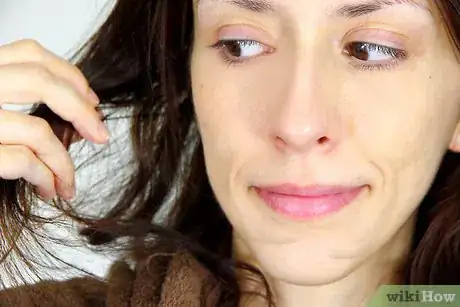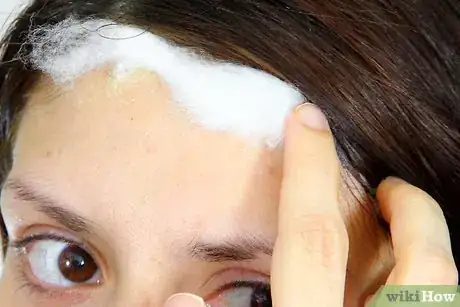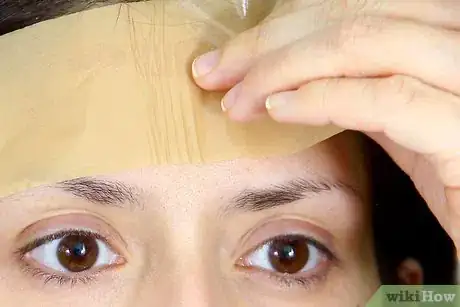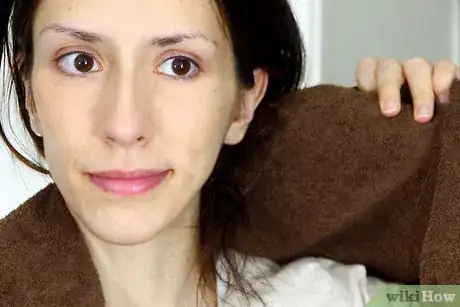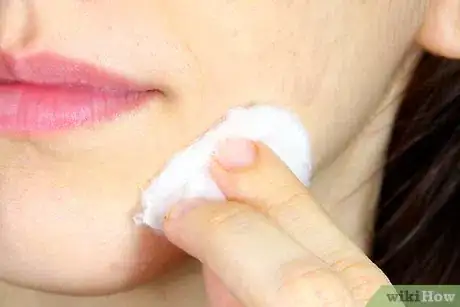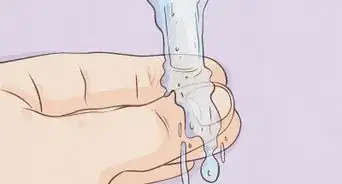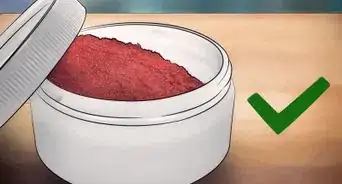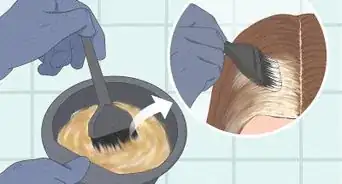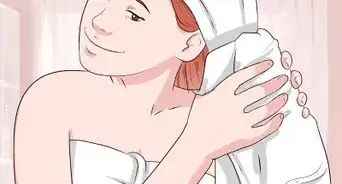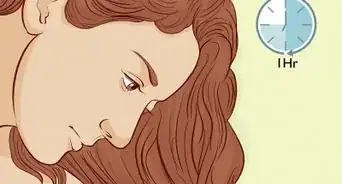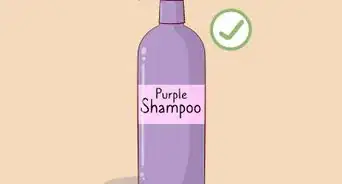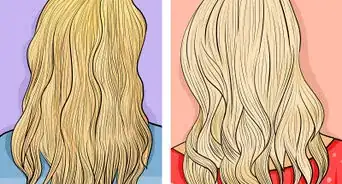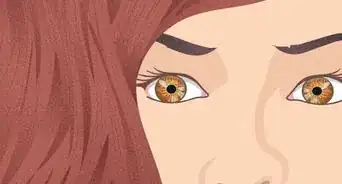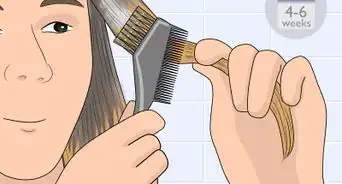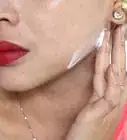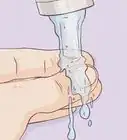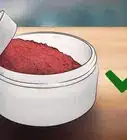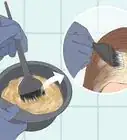This article was co-authored by Ashley Adams. Ashley Adams is a Licensed Cosmetologist and Hair Stylist in Illinois. She completed her Cosmetology education at John Amico School of Hair Design in 2016.
wikiHow marks an article as reader-approved once it receives enough positive feedback. In this case, 91% of readers who voted found the article helpful, earning it our reader-approved status.
This article has been viewed 402,403 times.
Purple hair is a great look, but a purple forehead is not! When you’re coloring your hair at home, you can end up with stains on your fingers and hairline for days if you do not take the proper precautions. Though these dye stains are not permanent, it’s easier to prevent them than it is to remove them. By making use of common household items, from towels to petroleum jelly, you can easily prevent hair dye from staining your skin.
Steps
Protecting Your Hairline
-
1Dye your hair the day after you wash it. The oils from your scalp and pores are natural protectants. They repel water, and since dyes are water-based, they are your first defense against stained skin. Try to wait at least one day after your last shampoo to dye your hair. Bonus: hair dye adheres better to dirty hair than it does to slippery, clean hair.[1]
-
2Protect the perimeter of your hairline. Using petroleum jelly, moisturizing cream, or a thick lotion to create a protective wall just outside of your hairline, around the entirety of your head. You should apply this layer thickly, but there’s no need to make it extend too far down your head. Half an inch to an inch of moisturizer should be plenty.
- Be careful not to get your protectant of choice in your hair, and don't forget the tops and undersides of your ears.
- Don’t use a moisturizer that breaks you out, or you could get acne around your hairline.
Advertisement -
3Reinforce the perimeter with cotton. For extra protection, press teased-out cotton balls, or cotton coil, into the moisturizer you applied. This way, if any hair dye manages to seep out of the hairline, the cotton will soak it up.[2]
- If the moisturizer isn’t sticky enough to hold the cotton, don’t panic--just apply more moisturizer over it, and forget about the cotton.
-
4In a pinch, try masking tape. If you don’t have any moisturizer thick enough to get the job done, don’t despair. Instead, you can use a lightly adhesive painter’s, masking, or gaffer’s tape applied to the edge of your hairline. Be careful not to catch your hair in the tape, and definitely don’t use another type of tape (like masking or duct) instead![3]
- Be careful when pulling tape off. Masking tape can potentially pull out or irritate the soft, fine hair known as vellus hair that covers your body, including your face.
Protecting Your Neck, Shoulders, and Hands
-
1Wear plastic gloves. People often concentrate on keeping their hairlines stain-free, but forget about their hands. It’s easy to avoid blue fingers and nails if you wear simple disposable gloves. Wear gloves the whole time you apply the dye, and even the first few times you wash your newly colored hair.
- Many hair dye kits come with gloves to make the process easier.
- Don’t wear latex gloves if you’re allergic! There are plenty of latex-free alternatives available.
-
2Wear an old shirt. Ideally, you should wear a long-sleeved, high-necked shirt when you dye your hair. Cover as much skin as you can, to protect against drips that can cause stained skin. Once you’ve been doing this for a while, you’ll probably have a designated dye shirt that you wear every time you color.[4]
-
3Wrap an old towel around your shoulders. To offer your neck some extra protection, swaddle it in a hand towel that no one will get mad at you for staining. Pull it tightly, and secure with a duckbill or binder clip. This will prevent hair dye from dripping down onto your neck and staining it.
-
4Wipe away any errant dye. No matter how carefully you cover your skin, accidents can happen. If dye does land on your face or neck, wipe it off as soon as you notice, using a rubbing alcohol-soaked cotton ball.[5] Then, rinse with water.
- It’s best to keep rubbing alcohol and cotton balls handy as you color your hair. Most people have a small mess-up or two.
- If you get a giant blob on your neck, remove the bulk of it with a paper towel or toilet paper, then use the cotton ball and rubbing alcohol to get the last of it off.
-
5Keep your dyed hair up. If you’re working out, going out in the rain, or in any other circumstance where your freshly-dyed hair could get damp, put it up in a ponytail or bun. Otherwise, residual dye could sneak out and stain your neck or even your shirt. Once you’ve washed your hair a few times, you can relax this rule.[6]
Expert Q&A
Did you know you can get expert answers for this article?
Unlock expert answers by supporting wikiHow
-
QuestionHow do I get hair dye stains off my face?
 Laura MartinLaura Martin is a Licensed Cosmetologist in Georgia. She has been a hair stylist since 2007 and a cosmetology teacher since 2013.
Laura MartinLaura Martin is a Licensed Cosmetologist in Georgia. She has been a hair stylist since 2007 and a cosmetology teacher since 2013.
Licensed Cosmetologist
-
QuestionWhat is the best way to get hair dye off your skin?
 Laura MartinLaura Martin is a Licensed Cosmetologist in Georgia. She has been a hair stylist since 2007 and a cosmetology teacher since 2013.
Laura MartinLaura Martin is a Licensed Cosmetologist in Georgia. She has been a hair stylist since 2007 and a cosmetology teacher since 2013.
Licensed Cosmetologist
-
QuestionHow do you take off dye from skin?
 Laura MartinLaura Martin is a Licensed Cosmetologist in Georgia. She has been a hair stylist since 2007 and a cosmetology teacher since 2013.
Laura MartinLaura Martin is a Licensed Cosmetologist in Georgia. She has been a hair stylist since 2007 and a cosmetology teacher since 2013.
Licensed Cosmetologist
Warnings
- Even the best protection won't prevent at least a little staining from black hair dye, so be prepared to do some dye removal or to wait for the stains to fade if you plan on coloring your hair black.⧼thumbs_response⧽
- Do not use hair conditioner to make a perimeter around your hairline, especially if you have sensitive skin. Prolonged exposure of hair conditioner to facial skin can cause major acne breakouts.⧼thumbs_response⧽
- If you must use a hair color stain remover on your skin, be sure to completely avoid your hair with it, so as to avoid stripping its new color.⧼thumbs_response⧽
- Know that semi-permanent hair colors sometimes bleed after the first wash, causing stained skin after the fact. In this case, you will have to use a stain remover.⧼thumbs_response⧽
Things You’ll Need
- Petroleum jelly or thick moisturizer
- Cotton balls
- Disposable gloves
- Old t-shirt
- Old towel
- Binder clip
- Rubbing alcohol
References
- ↑ http://stylecaster.com/beauty/coloring-your-hair/
- ↑ http://www.goodhousekeeping.com/beauty/hair/a35913/how-to-remove-hair-dye-from-skin/
- ↑ http://www.thriftyfun.com/tf592880.tip.html
- ↑ http://www.herinterest.com/temporary-hair-dye/
- ↑ https://mom.me/lifestyle/1615-rid-hair-dye-stains-skin/
- ↑ https://www.yahoo.com/beauty/help-my-hair-dye-is-bleeding-all-over-me-118449473663.html
About This Article
To stop hair dye from staining your skin, apply some petroleum jelly or thick lotion to the perimeter of your hairline, including the tops of your ears. If you don't have any petroleum jelly or lotion, try covering the skin along your hairline with tape instead. Before you dye your hair, drape a towel around your shoulders and put on plastic gloves, which will help keep dye off your neck and hands. If you do get any dye on your skin, wipe it off as quickly as possible using a cotton ball and rubbing alcohol. To learn how to use cotton to prevent dye from staining the skin around your hairline, keep reading!
